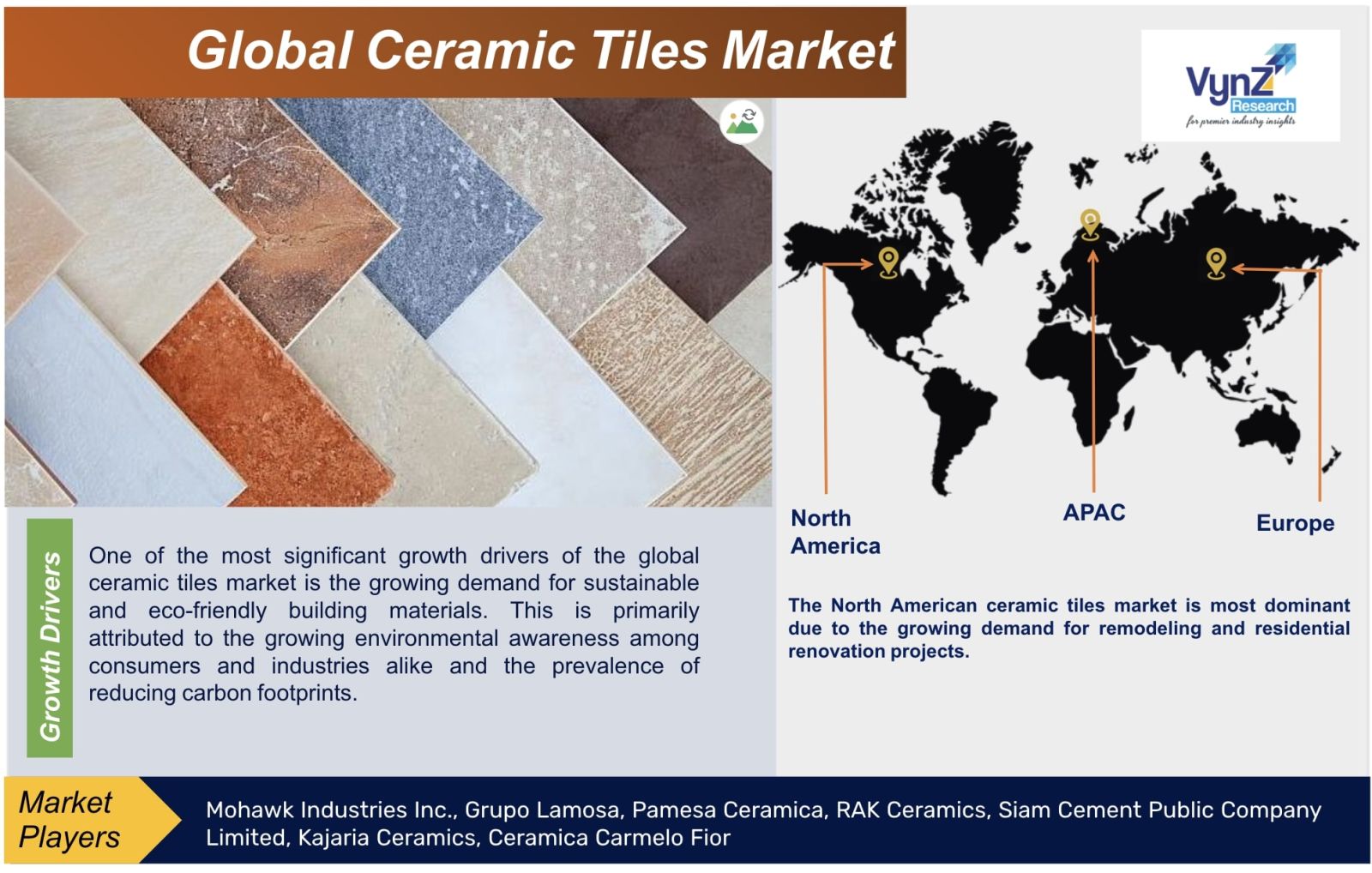| Status : Published | Published On : Oct, 2024 | Report Code : VRCH2110 | Industry : Chemicals & Materials | Available Format : | Page : 190 |

Global Ceramic Tiles Market Size & Share | Growth Forecast Report 2030
Industry Insights By Product Type (Glazed, Porcelain, Scratch-Resistant, Matte, and Other Specialty Tiles), By Application (Residential, Commercial, and Industrial sectors), By Construction Type (New Construction and Renovation Projects), By Usage (flooring, wall tiles, countertops, and other applications), By Distribution Channel (Retail Stores, Online Sales, and Direct-To-Consumer (DTC) channels), By Raw Material (Clay-Based, Sand-Based, Silica-Based, and Feldspar-Based categories), By Technology (Traditional Processes, Digital Printing, and Green Manufacturing Methods) and By Geography (Asia-Pacific, North American, Europe, Middle East & Africa)
Industry Overview
The global Ceramic Tiles Market size was valued at USD 190.4 billion in 2023. It is expected to grow and reach up to USD 229.4 billion by 2030 at a CAGR of 3% during the forecast period ranging between 2025 and 2030. The increased adoption of ceramic tiles in smart homes that incorporate features like under-tile heating, built-in LED lighting, and more is one significant factor driving the growth of this market. These are extensively used in innovative architectural projects and smart home designs that enhance both visual appeal and functionality.

Ceramic tiles refer to a specific type of building material. These are made from natural clay, sand, and water. They are molded into desired shapes and baked at high temperatures. The technology used is most advanced and includes digital printing, precision glazing, and 3D modeling. These technologies improve their aesthetics and durability. Available in different finishes such as matte, glossy, and textured, these versatile tiles offer several benefits, such as resistance to stains and moisture, ease of maintenance, eco-friendliness, and endless design possibilities. These are extensively used in kitchens, bathrooms, living rooms, and commercial spaces such as restaurants, offices, and hotels.
Global Ceramic Tiles Market Report Coverage
|
Report Metric |
Details |
|
Historical Period |
2018 - 2023 |
|
Base Year Considered |
2024 |
|
Forecast Period |
2025 - 2030 |
|
Market Size in 2024 |
U.S.D. 190.4 Billion |
|
Revenue Forecast in 2030 |
U.S.D. 229.4 Billion |
|
Growth Rate |
3% |
|
Segments Covered in the Report |
Product Type, Application, Construction Type, Usage, Distribution Channel, Raw Material and Technology |
|
Report Scope |
Market Trends, Drivers, and Restraints; Revenue Estimation and Forecast; Segmentation Analysis; Impact of COVID-19; Companies’ Strategic Developments; Market Share Analysis of Key Players; Company Profiling |
|
Regions Covered in the Report |
North America, Europe, Asia Pacific, Middle East and Africa |
Global Ceramic Tiles Industry Dynamics
Global Ceramic Tiles Market Trends/ Growth Drivers:
Growing demand for sustainable and eco-friendly materials
One of the most significant growth drivers of the global ceramic tiles market is the growing demand for sustainable and eco-friendly building materials. This is primarily attributed to the growing environmental awareness among consumers and industries alike and the prevalence of reducing carbon footprints.
Rising urbanization and construction activities in residential and commercial sectors are also contributing significantly to market growth, especially in developing countries such as Asia-Pacific, the Middle East, and Africa.
Technological developments in tile manufacturing and green practices also propel the market growth. Innovative technologies such as digital printing, 3D modeling, and nanotechnology have transformed the ceramic tile industry, allowing high-definition printing on tiles to create more intricate textures and designs that mimic natural materials like wood, stone, or marble. It has enhanced durability and resistance of materials, thereby driving the market growth.
Rising disposable income among people in developing economies is another significant factor driving the growth of the global ceramic tiles market. With a higher purchasing power, they can afford aesthetically pleasing and durable home décor products like ceramic tiles for their interior design solutions. This and the higher standard of living in these regions propels the demand for stylish and contemporary flooring solutions, thereby driving market growth.
The rapid growth in commercial infrastructure such as hotels, office spaces, hospitals, and shopping malls, as well as the growing popularity of large format and thin tiles for a seamless look, along with the increase in demand for anti-slip and hygienic ceramic tiles, is driving the demand and fueling the market growth. Supportive government initiatives and the growth of e-commerce platforms have also contributed to the growing adoption of ceramic tiles in residential and commercial settings and propelled the market growth.
Global Ceramic Tiles Market Challenges
High energy consumption during production
One of the most significant challenges faced by the global ceramic tiles market is the high energy requirement for manufacturing them. This is because these tiles need firing at high temperatures that need a lot of energy. This increases the cost of production as well as carbon emissions. This, in turn, increases the concerns over sustainability. Furthermore, the varying prices of raw materials further increase the cost burden on the manufacturers. Add to that, the industry faces stiff competition from low-cost alternative materials like vinyl and wooden flooring which are easier to install as well. All these, along with the transportation of heavy ceramic tiles and logistical issues, hinder the market growth.
Global Ceramic Tiles Market Opportunities
Rising demand for sustainable and green building materials
The global ceramic tiles market has significant growth opportunities due to the growing demand for sustainable and eco-friendly building materials. Today, consumers and governments are more environmentally conscious and, therefore, prefer green practices to reduce carbon footprints. The manufacturers trying to develop energy-efficient tiles, such as solar tiles, offer them an opportunity to meet their commitment to the environment. This, along with expanding urbanization in developing economies, offers significant growth potential for the global ceramic tiles market.
Recent Developments By Key Players:
RAK Ceramics (a global leader in ceramics) has opened its cutting-edge, spacious 8500-square-foot Experience Centre in Bengaluru. This unique space would not be just a showroom but a hub of innovation and inspiration. It shall redefines how customers interact with premium design solutions.
B.Grimm Power Service Limited created its subsidiary B.Grimm Power Future Solution Limited (BGPFS). BGPFS collaborated with Siam City Power Co., Ltd. (SCP) which is a subsidiary of Siam City Cement Public Company Limited to operate solar energy generation.
Global Ceramic Tiles Market Segmentation
Insight by Product Type
- Glazed
- Porcelain
- Scratch-Resistant
- Matte
- Other Specialty Tiles
Glazed tile dominates the market
The global ceramic tile market is segmented by product type into Glazed, Porcelain, Scratch-Resistant, Matte, and Other Specialty Tiles. Out of all these segments, the glazed tiles segment dominates the market due to their wide range of colors and beautiful finishes, making them suitable for use in decorative purposes.
Insight by Application
- Residential
- Commercial
- Industrial sectors
Residential segment dominates
Based on application the global ceramic tiles market is divided into Residential, Commercial, and Industrial sectors. Out of these three major sectors, the residential segment tends to dominate the market, being the largest contributor due to growing home renovation projects and higher demand for durable flooring with aesthetic finishes.
Insight by Construction Type
- New Construction
- Renovation Projects
New Construction segment outshines others
By construction type, the global ceramic tiles market is divided into New Construction and Renovation Projects, where the former is more prominent especially due to the growing urbanization initiatives in emerging markets. It is also attributed to the growing government infrastructure initiatives that drive large-scale building constructions.
Insight by Usage
- Flooring
- Wall Tiles
- Countertops
- Other Applications
The flooring segment is more dominant
The various uses of ceramic tiles divide the global ceramic tile market into flooring, wall tiles, countertops, and other applications. Among them, the flooring tiles segment dominates the market due to higher durability and moisture resistance, making them more suitable for high-traffic areas.
Insight by Distribution Channel
- Retail Stores
- Online Sales
- Direct-To-Consumer (DTC) channels
Retail stores dominate the market
Based on different distribution channels, the global ceramic tiles market is categorized into Retail Stores, Online Sales, and Direct-To-Consumer (DTC) channels. The retail stores segment is expected to dominate the market during the forecast period, especially in developing regions, due to higher preference among consumers as they can examine the tiles physically before purchasing. However, the direct-to-consumer (DTC) model is also gaining popularity since manufacturers are trying to organize sales and offer modest pricing.
Insight by Raw Material
- Clay-Based
- Sand-Based
- Silica-Based
- Feldspar-Based categories
Clay-based tiles are the most common
The global ceramic tiles market is also segregated by raw materials into Clay-Based, Sand-Based, Silica-Based, and Feldspar-Based categories. Out of them, the clay-based tile segments dominate the market, being the most commonly used product that offers a balance between performance and cost.
Insight by Technology
- Traditional Processes
- Digital Printing
- Green Manufacturing Methods
Digital Printing prevails and dominates
Based on technology, the global ceramic tiles market is segmented into Traditional Processes, Digital Printing, and Green Manufacturing Methods. Digital printing technology is expected to dominate the market due to better textures, designs, textures, and high-definition finishes that resemble natural materials such as wood, marble, and more.
Global Ceramic Tiles Market: Geographic Overview
The North American ceramic tiles market is most dominant due to the growing demand for remodeling and residential renovation projects. It is also attributed to the growing urbanization and the rising prevalence of sustainable construction in this region.
In Europe, the growth of the ceramic tiles market is attributed to stringent building regulations that promote eco-friendly materials. Furthermore, higher investments in infrastructure development and a preference for improving home aesthetics also contribute to market growth.
The Asia Pacific region is expected to grow at a higher CAGR during the forecast period, primarily due to rapid urbanization and growing construction activities. It is also attributed to the rising disposable incomes among people and high population growth in countries like India and China.
The Middle East and Africa region show significant growth promises due to rising urbanization, large-scale infrastructure projects, and higher investments in luxury real estate projects.
Global Ceramic Tiles Market Competitive Insight:
- Mohawk Industries Inc.
- Grupo Lamosa
- Pamesa Ceramica
- RAK Ceramics
- Siam Cement Public Company Limited
- Kajaria Ceramics
- Ceramica Carmelo Fior
PRIMARY RESEARCH INTERVIEWS - BREAKDOWN
.png)
Frequently Asked Questions
Purchase Options
Latest Report
Research Methodology
- Desk Research / Pilot Interviews
- Build Market Size Model
- Research and Analysis
- Final Deliverabvle
Connect With Our Sales Team
- Toll-Free: 1 888 253 3960
- Phone: +91 9960 288 381
- Email: enquiry@vynzresearch.com
Ceramic Tiles Market
